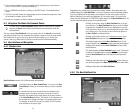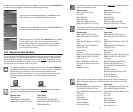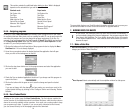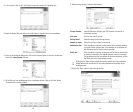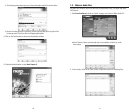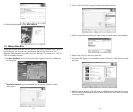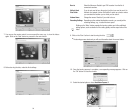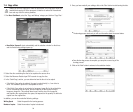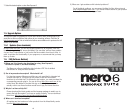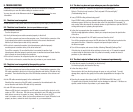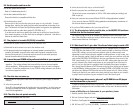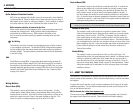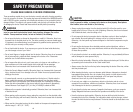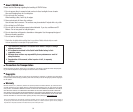
To ensure the correct operation of your new drive, updates to the firmware will be made
available as necessary. You can find information about the most recent firmware for the
drive on the Memorex web site.
URL for the web site is http://www
.memorex.com
The most recent user support information, including firmware updates, can be found in
the support area of Memorex’s web site. Please check this information regularly.
Important Note: The firmware is completely unrelated to the CD/DVD writing application software.
Packet Writing
This method is used to record data onto a disc on a file-by-file basis. This
method divides a track into small segments called “packets” so that data can be
written on a packet-by-packet basis, which means that you can write data in
much the same way as you can copy data to a floppy or hard drive. Since the
data can be written easily, packet writing is proper to daily data backup. Packet
writing also enables you to add packets to a disc as long as there is free space
available on the disc.
9.1. ABOUT THE FIRMWARE
The “firmware” is a small piece of software built into the Memorex DVD recorder, and is
used to control its basic operation. Since it resides in flash memory, it can be overwritten
and updated.
47
Important Note: Ordinary audio CD players can only playback single-session discs or the first
session on a multi-session disc. Do not record audio data on the second and subsequent sessions.
Session-at-Once (SAO)
This method is used to write all data on a session-by-session basis. Unlike
Track-at-Once described above, Session-at-Once enables you to record multiple
tracks onto a disc at at a time. CD EXTRA, for example, uses this method to
write multiple pieces of audio data (or multiple tracks) in the first session and
information required for computers in the second session. This method enables
you to add data into the same disc, one session at a time, as long as there is free
space available on the disc. A disc that contains data written in several sessions
by this method is defined as a multi-session disc, like a disc written by the
Track-at-Once method.
Writing Methods
Disc-at-Once (DAO)
This method is used to write all data onto a disc in one operation. It writes
multiple pieces of data without placing a space between data, starting with the
innermost track of the disc. Once data is written by this method, no data can be
added to the same disc even if there is free space available on the disc. This
method is useful for making a backup copy of an entire CD or DVD.
Track-at-Once (TAO)
This method is used to write all data on a track-by-track basis. A track can be
defined as the smallest unit of area that contains an ordinary program, image
file, text file, etc. This method enables you to add data to the same disc, one
track of data at a time, as long as there is free space available on the disc. A
disc that contains data written in several sessions is defined as a multi-session
disc. An area that records data and management information (Lead-in/Lead-out)
is defined as a session. Lead-in and Lead-out are signals written for stating the
starting and ending points of one session.
46
9. APPENDIX
Technical Notes
Buffer Underrun Protection Function
DVD drives are equipped with a buffer memory that temporarily stores data that
is being transferred. When the buffer memory becomes empty due to a delay of
data transfer for any reason, a writing error happens. Such a condition is defined
as a buffer underrun; such an error is defined as a buffer underrun error.
Buffer underrun protection is featured in this drive.
When a buffer underrun almost happens, buffer underrun protection temporarily
suspends the writing process. Writing resumes when enough data has
accumulated in the buffer memory. Buffer Underrun Protection in this
drive is extremely accurate, resulting in seamless recording before and after
suspension.
Test Writing
Test writing is a function to check for the possible occurance of buffer underrun
in your computer environment. The included CD/DVD writing software operates
the test writing function that cannot operate when buffer underrun protection is
activated (default). The buffer underrun protection should be first be deactivated
to use test writing.
DMA
Direct Memory Access(DMA), is support that allows data transfer between the
drives and memory without using the CPU. Both the drives and IDE controller in
the machine on the motherboard must include support for DMA. Also, you must
manually enable the operating system to support DMA, this is done in the System
section in the Control Panel where the drive settings are. See “Important Notes”
on page 16 of section 3



